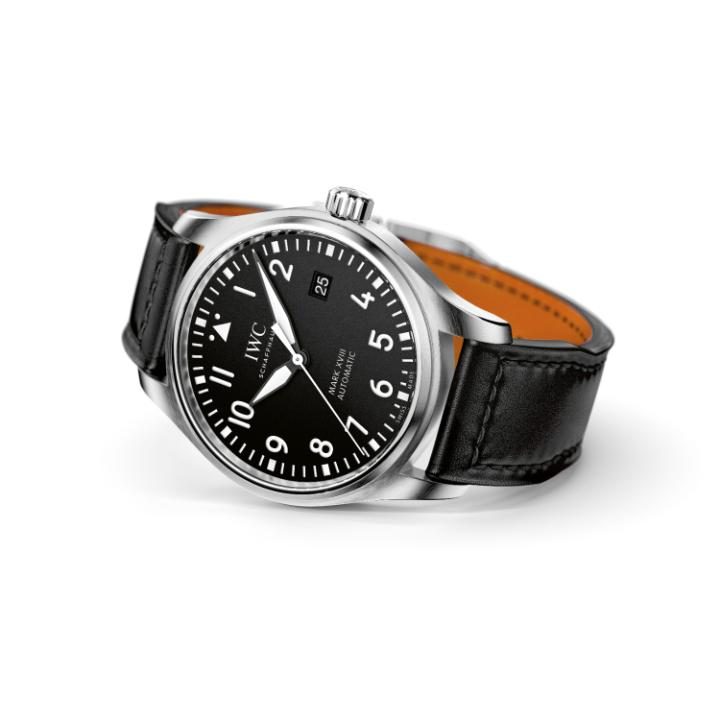IWC’s pilot replica watches: mapping the flight path of a timepiece icon
It is an irony worth savouring that IWC’s longest-lasting model was designed not by the Swiss but by bureaucrats from Britain’s post-Second World War Air Ministry, for whom it would go into service for 40 years. Rediscovered in the 1990s and a staple of the manufacturer’s offering ever since, it is a design that has endured as the archetypal military aviation watch, celebrated this year in a newly stripped-back form: the Mark XVIII Replica.
Originally known as the Mark 11, the watch’s heritage actually stretches back to the wartime missions of RAF Bomber Command and a post-war survey which revealed that less than five per cent of bombs had been on target. Poor navigation was cited as the primary cause, so the old system of “dead reckoning” (determining your present position by projecting your course and speed from a known past position) was abandoned and the focus turned to astro-navigation. This required three key elements: the use of a star chart, a bubble sextant and – last but not least – an extremely accurate timepiece , along with someone trained in their use .In 1946/7, the Air Ministry issued Specification G943 for a new watch to be used for this purpose and Goldsmiths & Silversmiths (G&S) was the firm appointed with providing the British Armed Forces with an appropriate model.
G&S, which had worked with names such as Omega, Zenith, Movado and Longines during the war, sent the specification to a number of watchmakers but only two came back with specific proposals: Jaeger-LeCoultre and IWC. This was probably because the replica watches had to perform to exacting accuracy standards, and to be protected from magnetic interference caused by radar equipment and other electromagnetic sources in the planes. A soft iron inner case – much like a Faraday cage – was therefore used to enclose the movement, shielding it from magnetic forces. But ask what defines the Mark 11 and in most people’s eyes it’s the dial: matte black with luminous bar indices at the quarter hours.

The numeral 12 was initially differentiated by two luminous dots either side of the bar, but a more legible luminous triangle was added on the second-generation dials to replace the printed number.The first shipment of watches was from Jaeger-LeCoultre, but subsequent deliveries (totaling around 8,000) were from IWC, fitted with the brand’s famous Cal. 89 movement and upgraded to meet the RAF’s tight timekeeping specification. Once a year the watches were sent back to the Royal Observatory at Herstmonceaux to confirm their timekeeping was meeting the required standard and to bring it back to specification if needed.In addition, the replica watches were fitted with a practically impermeable case – one that still looks good today, almost 70 years after it was introduced.As well as being procured by the British Air Ministry for the RAF, the Mark 11 was used by the air forces of several Commonwealth countries, notably Australia, New Zealand and South Africa, as well as government-owned BOAC (the predecessor to British Airways), which ordered a quantity for its navigators
But by the mid-1960s, astro-navigation had been superseded by a network of radio beacons and the Mark 11 became redundant, except as a back-up. The IWC Copy Watches UK were slowly withdrawn from use and, in the late 1970s, the RAF began selling them as surplus at government property sales.That may well have been the last we heard of the Mark 11. Then, in 1993, after IWC had witnessed the watch’s popularity with collectors, it launched an updated version – the Mark XII (the RAF used Arabics for their model types, whilst IWC use Roman numbers). A date window upset the symmetry of the original dial, but otherwise the look of the watch was an excellent homage to the Mark 11.
Subsequent versions followed. In 1999, the slightly larger Mark XV made its debut (yes, it did go from Mark XII to Mark XV. I can understand why the Mark XIII was leapfrogged, but remain baffled as to why there was no XIV). And in 2006, it was the turn of the Mark XVI, which showed significant aesthetic changes under the influence of the brand’s other aviation headliner: the Big Pilot’s Replica Watch. Despite casting history aside, the Mark XVI was still a sales hit and was in production until 2011, when the revised Mark XVII launched. Bigger still, and with a sector date display, it was a far cry from the pure, stripped-back functionality of its forebear. Now, in 2016, it’s all-change again, with the unveiling of the IWC Mark XVIII: now shrunk back to 40mm, abandoning the sector date display and bringing back the numbers 6 and 9. Admittedly, the hands are still those of the Big Pilot but this is an attractive and admirably austere version, and a worthy descendent of the watch that flew with British pilots for decades.
The IWC Mark 11 started being collected in the late 1980s, after the watches were sold off as surplus by the MOD. Recently, along with a strengthening market for vintage military watches in general, the collectability of Mark 11s has begun to soar. Eighteen months ago we would have sold a good one for around £4,000, now you’d expect between £6,000 and £6,500, plus a little more if it has an original archive extract,” says Silas Walton, founder of online vintage replica watch dealer, WatchXchange. Fundamentals include original luminescent markings – after tritium replaced radium this was marked by an encircled “t” on the dial – and military serial number engravings on the caseback. The much rarer Jaeger-LeCoultre models can go for around £1,000 more.











Post Comment